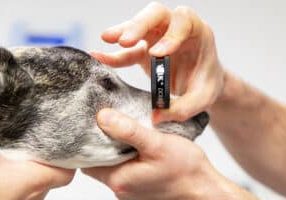
Spontaneous chronic corneal epithelial defects (SCCEDs), also known as indolent ulcers, Boxer’s ulcers or nonhealing ulcers, are noninfected, epithelial defects with a redundant, nonadherent epithelial border.
They are characterised by the presence of a thin hyaline membrane over the anterior stroma, which prevents adhesion of new epithelium. SCCEDs were first described in Boxer dogs and have since been described in other canine breeds, occurring most commonly in middle-aged to older patients. Recently it has been also documented that particularly in Boxers, a new SCCED may develop in the contralateral eye, typically within 24 months following a presentation of unilateral SCCED.
A variety of medical treatments aimed at modulating the wound healing process have been reported but these topical treatments alone are often not successful in resolving canine SCCEDs and a procedure is needed that removes or damages the hyaline membrane.

Clients should be counselled that multiple treatments are sometimes required to achieve healing. The following techniques have all been described:
Cotton tip debridement
After application of topical anaesthetic, loose epithelium is removed with a sterile cotton tip. This can be repeated at 7–14-day intervals, with healing rates of around 50% after 2 weeks.
Superficial grid keratotomy or punctate keratotomy
These techniques are usually performed under sedation or general anaesthesia and involve making multifocal punctures or linear scratches that just penetrate the anterior stroma. Healing rates of around 70-90% are reported after 2-3 weeks.
Diamond burr debridement
After removing the loose epithelium with a sterile cotton bud, the motorised burr is moved across the ulcer bed in a circular or grid pattern for 45-60 seconds. The healing rate is 80-90% after 2-3 weeks. For most patients this procedure can be performed with topical anaesthesia alone.
Superficial keratectomy
Surgical excision of the anterior stroma can be performed, to remove the hyaline membrane and allow new epithelium to adhere to the normal underlying stroma. General anaesthesia is required, and this surgery is likely to create more scarring than the less invasive procedures, as well as causing a degree of astigmatism. However, unlike the other procedures, the success rate across all studies is 100%.
Superficial keratectomy requires magnification (usually an operating microscope) and microsurgical skills. The other techniques are more easily learned, but in general require some training and knowledge of possible complications.
of the non-attached epithelium
By definition, SCCEDs are noninfected ulcers. Therefore, only prophylactic use of broad-spectrum topical antibiotics is recommended. In more chronic cases, it might be combined with systemic tetracyclines, such as doxycycline.
As with other corneal defects, SCCEDs are often painful. Therefore, topical cycloplegics such as topical cyclopentolate (up two three times daily) or atropine (once or twice daily for limited period of time) can be administered.
- Do not use topical atropine in animals with concurrent keratoconjunctivitis sicca or increased risk of glaucoma.
The use of bandage contact lenses is encouraged as it has been proven to improve comfort in various studies, with human contact lenses having longer retention time than veterinary ones. If a contact lens is to be applied, avoid the use of ophthalmic ointments as they may dislodge the lens more easily.
Autologous or heterologous topical serum is advocated treatment in many corneal ulcers and can be applied in SCCEDs although current available studies were unable to demonstrate improvement in healing times.
Topical artificial tears substituents may be applied, especially the ones rich in hyaluronic acid, in order to improve the corneal lubrication and smoothen the effect of eyelid blinking on the loose corneal epithelium.
The use of an Elizabethan Collar is necessary to prevent self-trauma.
Case Advice or Arranging a Referral
If you are a veterinary professional and would like to discuss a case with one of our team, or require pre-referral advice about a patient, please call 01883 741449. Alternatively, to refer a case, please use the online referral form
About The Discipline
Ophthalmology

Need case advice or have any questions?
If you have any questions or would like advice on a case please call our dedicated vet line on 01883 741449 and ask to speak to one of our Ophthalmology team.
Advice is freely available, even if the case cannot be referred.
Ophthalmology Team
Our Ophthalmology Team offer a caring, multi-disciplinary approach to all medical and surgical conditions.
